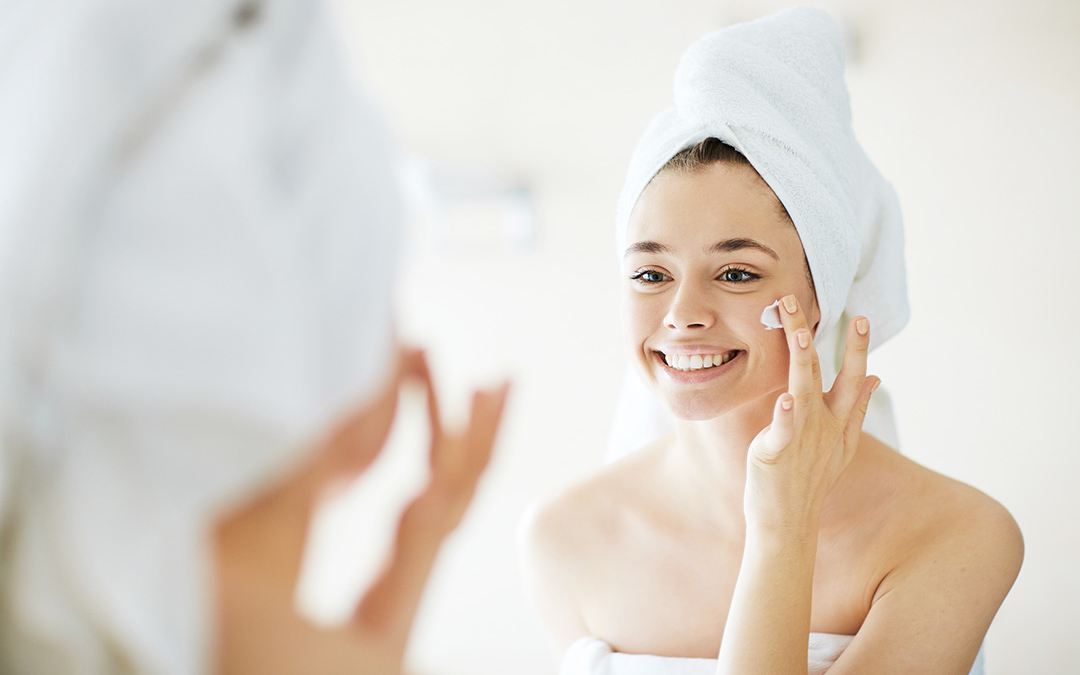Are you applying your skincare products in the best order?
In what order do you apply your skincare products? I bet you’ve heard the phrase ‘cleanse, tone and moisturise’. Is that your regular skincare routine morning and night? Does it matter anyway?
Hang on a minute! What about those special ‘active ingredient’ serums that you’ve been told can make big improvements to your skin? Where do they fit in? Help!!
Don’t panic! We’re here to explain it all, so sit tight for a rundown of the most effective way to apply your fave skincare products and avoid wasting your time and money.
Why is the layering of skincare products important?
Everyone’s skin profile is unique. It’s not as simple as having ‘dry’ or ‘oily’ skin. Those words disguise the amount of oil or the lack of natural hydration – which will be different in everyone. Factors like your age, your ethnicity, any medication you take and the environment you spend most time in – out in all weathers being active or sitting indoors with the central heating on full blast – will all have an effect.
If you’ve invested in some top quality skincare products that promise great results, but you’re not seeing improvements, maybe you’re applying them in the wrong order or at the wrong time of day.
Having a customised skincare routine is vital – and that includes layering your products correctly.
Is there one simple, golden rule for how to layer your skincare?
Yes! Well, two actually. The first golden rule is to start with the skincare product that has the thinnest texture and work up to the one that is the thickest. This means that thin serums go on first. This allows them to be absorbed into the skin before you get round to the thicker creams. Think about it – if you apply a thick cream first, a thinner serum or liquid just won’t be able to fight its way through the thick cream to reach your skin and do its job.
The second golden rule is that the last thing you should put on in the morning is an SPF (sun protection factor) product to protect you from the damaging UVA and UVB rays. SPF15 is the recommended minimum we should wear outside in the UK – even on cloudy days. If you apply this last, it means that it is the first thing that the rays hit. This is particularly important if you’ve been exfoliating with products that include retinol and glycolic acid. These can leave skin more prone to potential damage.
What is a good daytime skincare routine?
There are generally six steps to a good daytime skincare routine and this is the order we recommend that you apply your products.
- Cleansing is still the important first step of your morning skincare routine. Cleanse each morning with a cream or oil-based cleanser to remove any dead skin or impurities that may have built up while you were asleep.
- Toning is optional. A good quality toner will balance the skin’s pH, add moisture and remove any lingering traces of your cleanser. You can choose one containing a lactic acid or a mild glycolic if you want some exfoliating benefits. But if you are planning to use a cream containing retinol at night you might skip this (to avoid too much stress on your skin) and choose a toner that calms the skin.
- If you are going to be outside a lot, Vitamin C can give your skin some protection from pollution. It has lots of antioxidants that counteract free radicals, which are in the air we breathe, the medicines we take, the food we eat and water we drink. They can prematurely age the skin. Vitamin C is a superfood for your skin – so pop some on at this point if you wish and it should add a glow to dull skin over time.
- If you struggle with breakouts, this is the place in your routine to add an ‘active ingredient’ product to fight them off. This is another optional step.
- Moisturising comes next. The product you use here should be thicker than any products you have applied in the previous steps. A good moisturiser should lock in the goodness and benefits from the previous steps and also provide a barrier for your skin from the outside world. We would recommend a lighter moisturiser in the day and a heavier moisturiser at night, including added ingredients to help your skin repair overnight.
- The final step should be a product that protects your skin from sun damage. Even if you use foundation that includes SPF, you still need a broad spectrum sunscreen to ensure you are protecting the skin from UVA and UVB rays.
What is a good night time skincare routine?
- Double cleansing at the end of the day will ensure that all the dirt and make-up from the day is removed. So, apply your cleanser twice.
- Add an optional active ingredient here if you are tackling acne or breakouts but make sure that if you have sensitive skin that you choose something that won’t be too aggressive.
- For daytime we told you how great Vitamin C was. At night time it’s Vitamin A, or retinol, that provides great anti-ageing benefits. It can stimulate collagen and elastin that help to increase the appearance of firmness and reduce the look of fine lines and wrinkles. It also contributes towards improving uneven skin tone and texture.
- Moisturise as the final step. You can use a richer cream if you wish.
Are there any skincare products you shouldn’t apply at the same time?
This will depend on the formulations you are using and also how tolerant your skin is to some ingredients. Generally speaking, strong ingredients such as Vitamin A and acids (such as AHAs and BHAs) can irritate the skin if you apply them at the same time because they both exfoliate the skin so doubling up can make it too dry. If you have sensitive skin you may find that applying these high-strength active ingredients every OTHER day is enough for your skin.
Vitamin A can also react with Benzoyl Peroxide, which kills bacteria in anti-acne and blemish products. Avoid combining those products to avoid irritation and also because the Benzoyl Peroxide will cancel out the benefits of the Vitamin A.
The great news is that clever advances in how products are made means that other ingredients that might cancel each other out, or cause sensitivity, can be isolated in separate microcapsules. They are then only released when they reach their intended destination in the skin.
I’m still not sure about my skin type – what can I do next?
If you need more help to understand your skin profile and what your skin needs, you can book a consultation with one of our own AlumierMD-registered skincare professionals to create the right routine for you with safe, effective products. Contact us today to learn more.

